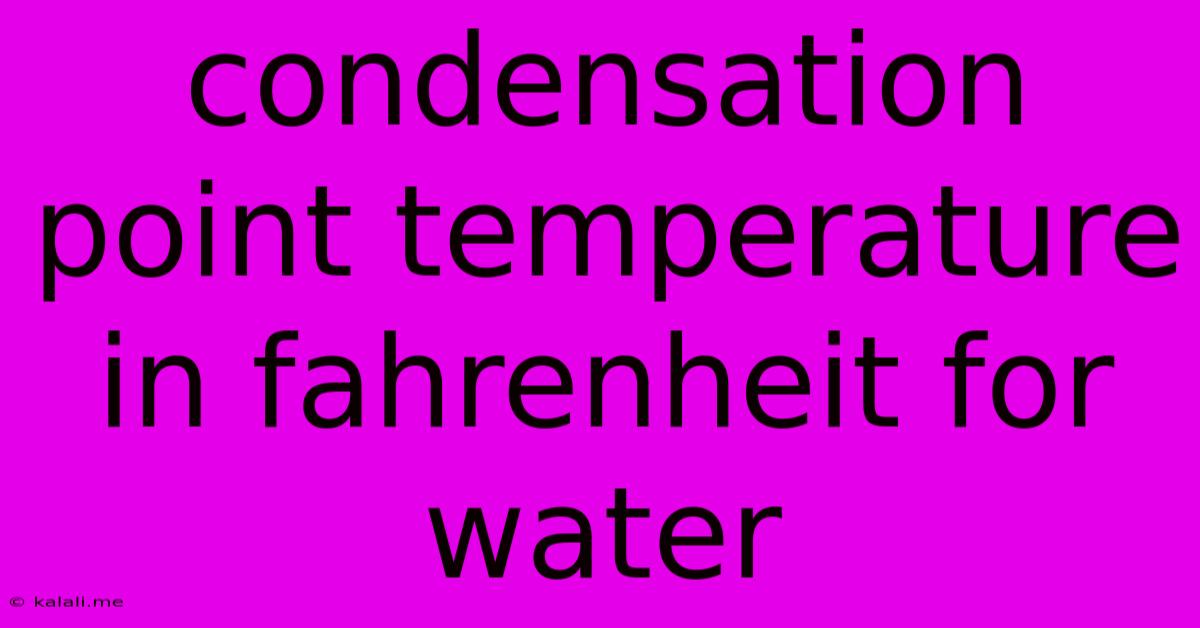Condensation Point Temperature In Fahrenheit For Water
Kalali
May 24, 2025 · 3 min read

Table of Contents
Understanding the Condensation Point Temperature of Water in Fahrenheit
The condensation point temperature of water, also known as the dew point, is the temperature at which the air becomes saturated with water vapor and the water vapor begins to condense into liquid water. Understanding this temperature is crucial in various fields, from meteorology and climate science to industrial processes and everyday life. This article will delve into the intricacies of the water condensation point temperature in Fahrenheit, exploring its implications and influencing factors.
What is the Condensation Point (Dew Point)?
The dew point isn't a fixed temperature; it's dependent on the amount of water vapor present in the air. Warmer air can hold more moisture than colder air. When the air cools down to its dew point, it can no longer hold all the water vapor it contains. This excess water vapor then condenses, forming dew, fog, or clouds, depending on the conditions. Think of it like a sponge – a warm, dry sponge can absorb a lot of water, but as it cools, its capacity to hold water decreases, causing the excess water to drip off.
The Condensation Point in Fahrenheit: A Variable Temperature
Unlike the boiling point of water, which is a constant 212°F (100°C) at standard atmospheric pressure, the condensation point temperature of water varies significantly. It's directly related to the relative humidity. High relative humidity indicates that the air is already close to saturation, meaning the dew point is relatively high and close to the current air temperature. Low relative humidity means the air can hold significantly more moisture before reaching saturation, resulting in a lower dew point.
Factors Affecting the Condensation Point
Several factors influence the condensation point:
- Air Temperature: As air temperature decreases, the dew point is approached more readily. Cooling the air is a common way to induce condensation.
- Water Vapor Content: The amount of water vapor in the air directly impacts the dew point. More water vapor means a higher dew point.
- Atmospheric Pressure: Changes in atmospheric pressure can slightly affect the dew point. Higher pressure generally allows the air to hold more water vapor.
- Altitude: As altitude increases, the air pressure decreases, leading to a lower dew point.
Practical Applications of Understanding the Condensation Point
Understanding the condensation point is crucial in many contexts:
- Meteorology: Predicting dew formation, fog, and cloud formation relies heavily on knowing the dew point.
- Agriculture: Farmers need to understand dew point to manage irrigation and prevent frost damage.
- Industrial Processes: Controlling condensation is essential in many industrial processes, such as manufacturing and storage.
- Construction: Understanding condensation is critical in designing buildings to prevent moisture buildup and mold growth.
Calculating the Dew Point
While complex formulas exist, several online calculators and weather apps readily provide dew point information based on air temperature and relative humidity. These tools are highly beneficial for accurate predictions.
In Conclusion:
The condensation point temperature of water in Fahrenheit is a dynamic value dependent on various atmospheric conditions. Understanding its influence is vital in a wide array of fields, highlighting its importance in both scientific understanding and practical applications. By considering the factors influencing this critical temperature, we can better predict and manage the effects of condensation in our environment.
Latest Posts
Latest Posts
-
Why Did Jesus Call Simon Peter
May 24, 2025
-
How To Tear Down A Chimney
May 24, 2025
-
You Might Not Like Me Using This Word
May 24, 2025
-
How To Make Mouse Click Silent
May 24, 2025
-
How Fast Does A Comet Move
May 24, 2025
Related Post
Thank you for visiting our website which covers about Condensation Point Temperature In Fahrenheit For Water . We hope the information provided has been useful to you. Feel free to contact us if you have any questions or need further assistance. See you next time and don't miss to bookmark.